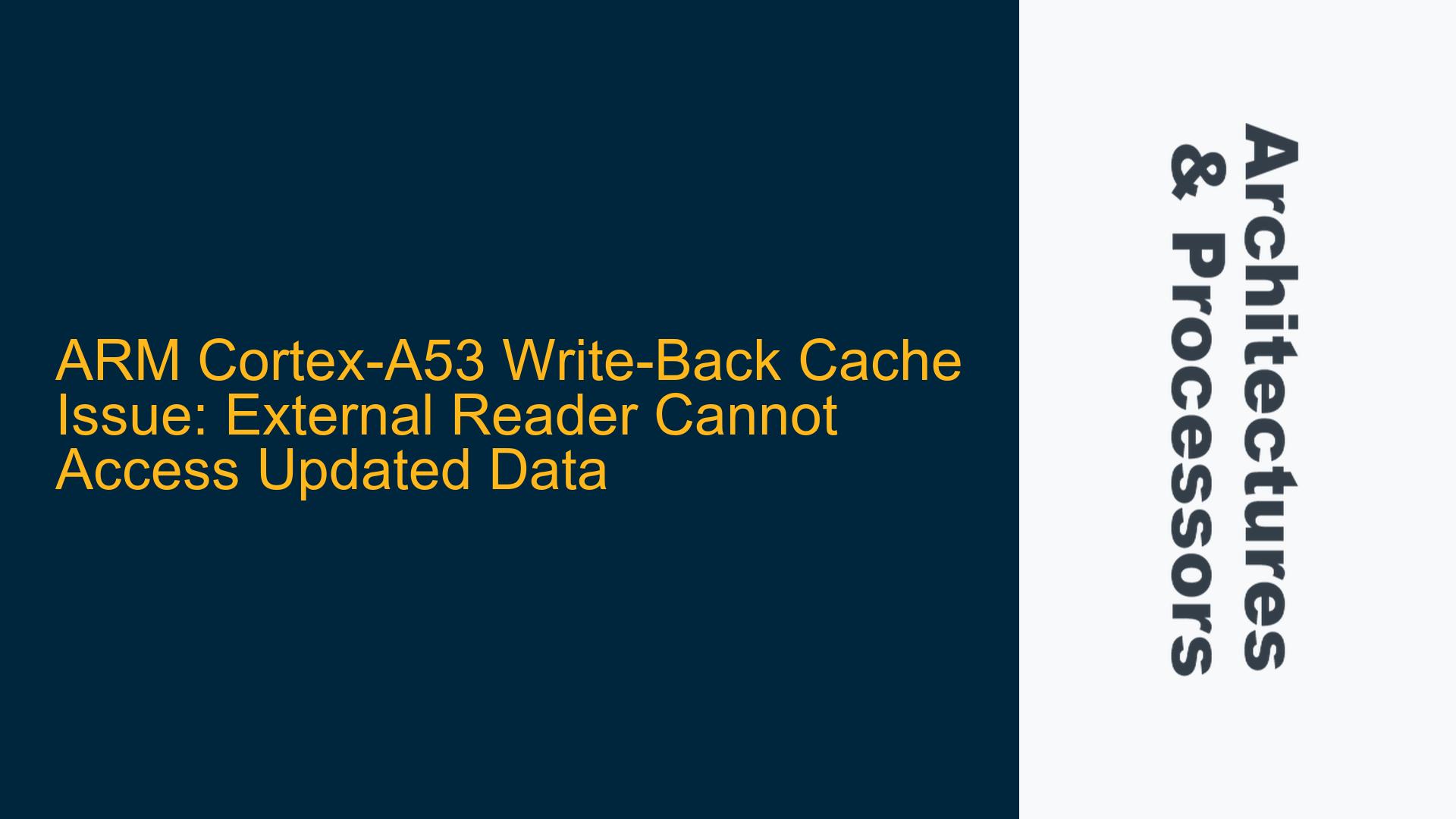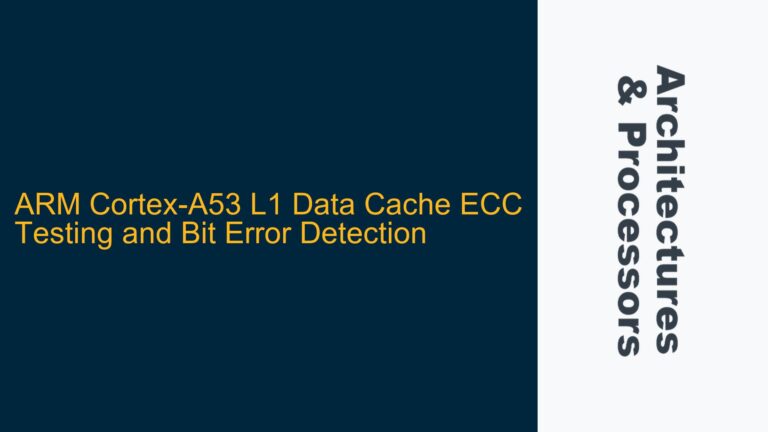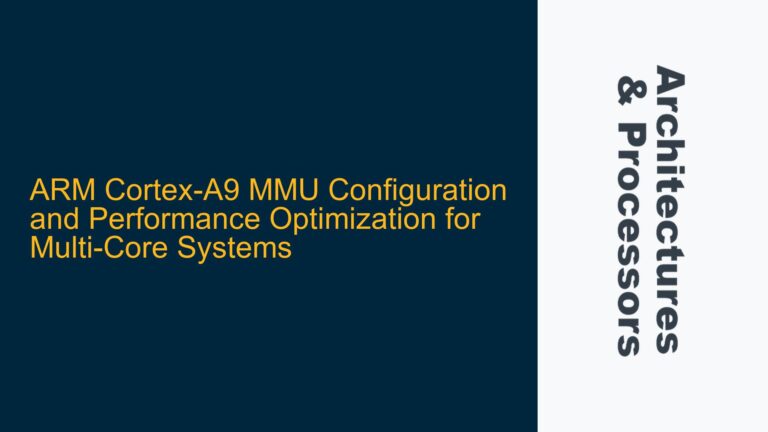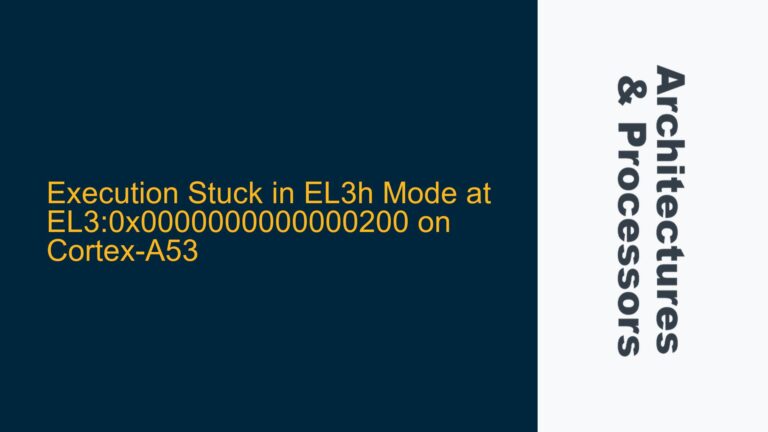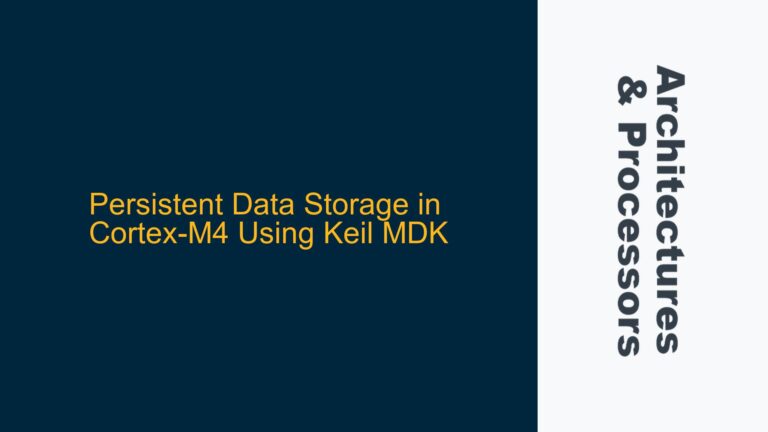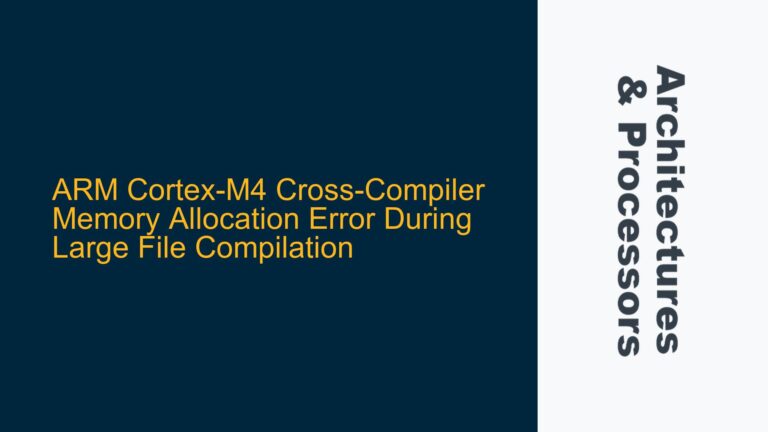ARM Cortex-A53 Write-Back Cache Behavior and External Memory Access
The ARM Cortex-A53 processor, part of the ARMv8-A architecture, is widely used in embedded systems due to its balance of performance and power efficiency. One of its key features is the support for configurable memory attributes, including write-back caching. Write-back caching is a memory optimization technique where data written to memory is initially stored only in the cache. The data is written back to the main memory (DDR) only when the cache line is evicted or explicitly cleaned. This behavior can lead to scenarios where an external reader, such as a DMA controller or another non-coherent device, cannot access the most recent data because the updated data resides only in the cache and has not yet been written to DDR.
In systems without an operating system (bare-metal systems), managing cache coherency becomes the responsibility of the software developer. When memory is configured as write-back, writes to a memory address may not immediately propagate to the DDR. This can cause issues when external devices attempt to read the data directly from DDR, as they may read stale data instead of the updated values. This issue is particularly problematic in systems where real-time data sharing between the processor and external devices is critical.
Non-Coherent External Devices and Cache Clean Operations
The root cause of the issue lies in the interaction between the Cortex-A53’s write-back cache and non-coherent external devices. A non-coherent device does not participate in the cache coherency protocol maintained by the ARM processor. As a result, it cannot see updates that are still held in the processor’s cache. When the Cortex-A53 writes data to a memory location configured with write-back caching, the data is stored in the cache but not immediately written to DDR. The external device, which reads directly from DDR, will not see the updated data until the cache line is cleaned and the data is written back to DDR.
To ensure that the external device can access the updated data, the software must explicitly clean the cache line corresponding to the memory address. Cleaning a cache line means writing the data from the cache to DDR and invalidating the cache line if necessary. The ARMv8-A architecture provides specific instructions for cache maintenance, such as DC CVAC (Data Cache Clean by Virtual Address to Point of Coherency). This instruction ensures that the data at the specified virtual address is written back to DDR, making it visible to non-coherent external devices.
Implementing Cache Maintenance Operations for Data Visibility
To resolve the issue of external readers not seeing updated data in a write-back cache configuration, the software must perform cache maintenance operations at the appropriate points in the code. The following steps outline the process for ensuring data visibility to non-coherent external devices:
-
Identify Critical Memory Regions: Determine the memory regions that are shared between the Cortex-A53 and external devices. These regions must be configured with the appropriate memory attributes, such as write-back caching, to optimize performance while ensuring data consistency.
-
Insert Cache Clean Instructions: After writing data to a memory location that is shared with an external device, insert a cache clean instruction (
DC CVAC) to ensure the data is written back to DDR. TheDC CVACinstruction takes the virtual address of the cache line to be cleaned as an operand. For example:DC CVAC, Xt // Clean the cache line containing the address in register XtThis instruction ensures that the data at the specified address is written back to DDR, making it visible to external devices.
-
Use Data Synchronization Barriers: To ensure that the cache clean operation completes before the external device accesses the data, insert a data synchronization barrier (
DSB) after the cache clean instruction. TheDSBinstruction ensures that all preceding memory operations, including cache maintenance operations, are completed before any subsequent instructions are executed. For example:DC CVAC, Xt // Clean the cache line DSB SY // Ensure the clean operation completes -
Optimize Cache Maintenance Overhead: While cache maintenance operations are necessary for data consistency, they can introduce performance overhead. To minimize this overhead, batch multiple cache clean operations together where possible and avoid unnecessary cleaning of cache lines that are not shared with external devices.
-
Validate System Behavior: After implementing cache maintenance operations, validate the system behavior to ensure that external devices can access the updated data. Use debugging tools, such as logic analyzers or memory monitors, to verify that the data is correctly written to DDR and read by the external device.
By following these steps, developers can ensure that data written by the Cortex-A53 processor is visible to non-coherent external devices, even when using write-back caching. This approach balances performance optimization with the need for data consistency in systems with shared memory regions.
Detailed Explanation of Cache Maintenance Instructions
The ARMv8-A architecture provides a comprehensive set of cache maintenance instructions to manage data visibility and coherency. Understanding these instructions is crucial for implementing effective cache management strategies in bare-metal systems. Below is a detailed explanation of the key cache maintenance instructions relevant to the issue at hand:
-
DC CVAC (Data Cache Clean by Virtual Address to Point of Coherency):
- Purpose: Cleans the cache line containing the specified virtual address, writing the data back to DDR if it has been modified.
- Usage: Used to ensure that data written by the processor is visible to non-coherent external devices.
- Syntax:
DC CVAC, Xt, whereXtis a register holding the virtual address to be cleaned. - Example:
MOV X0, #0x1000 // Load the address to be cleaned into X0 DC CVAC, X0 // Clean the cache line containing the address in X0
-
DSB (Data Synchronization Barrier):
- Purpose: Ensures that all memory accesses and cache maintenance operations before the
DSBinstruction are completed before any subsequent instructions are executed. - Usage: Used to synchronize memory operations and ensure that cache maintenance operations are completed before proceeding.
- Syntax:
DSB SY, whereSYspecifies a full system barrier. - Example:
DC CVAC, X0 // Clean the cache line DSB SY // Ensure the clean operation completes
- Purpose: Ensures that all memory accesses and cache maintenance operations before the
-
DC CIVAC (Data Cache Clean and Invalidate by Virtual Address to Point of Coherency):
- Purpose: Cleans and invalidates the cache line containing the specified virtual address, writing the data back to DDR if it has been modified and then invalidating the cache line.
- Usage: Used when both cleaning and invalidating a cache line are required, such as when reusing a memory region for new data.
- Syntax:
DC CIVAC, Xt, whereXtis a register holding the virtual address to be cleaned and invalidated. - Example:
MOV X0, #0x1000 // Load the address to be cleaned and invalidated into X0 DC CIVAC, X0 // Clean and invalidate the cache line containing the address in X0
-
ISB (Instruction Synchronization Barrier):
- Purpose: Ensures that all instructions before the
ISBare completed before any subsequent instructions are executed. This is particularly important when changing memory attributes or cache configurations. - Usage: Used to ensure that changes to memory attributes or cache configurations take effect before proceeding.
- Syntax:
ISB SY, whereSYspecifies a full system barrier. - Example:
MRS X0, SCTLR_EL1 // Read the System Control Register ORR X0, X0, #0x4 // Enable the cache MSR SCTLR_EL1, X0 // Write back to the System Control Register ISB SY // Ensure the cache enable takes effect
- Purpose: Ensures that all instructions before the
Practical Example: Ensuring Data Visibility in a DMA Transfer
Consider a scenario where the Cortex-A53 processor writes data to a memory buffer that is subsequently read by a DMA controller. The DMA controller is a non-coherent device and reads data directly from DDR. To ensure that the DMA controller reads the correct data, the following steps must be taken:
-
Configure Memory Attributes: Configure the memory buffer with write-back caching to optimize performance.
// Example: Configure memory attributes for write-back caching configure_memory_attributes(buffer_address, buffer_size, WRITE_BACK); -
Write Data to the Buffer: Write data to the memory buffer using the Cortex-A53 processor.
// Example: Write data to the buffer uint32_t *buffer = (uint32_t *)buffer_address; for (int i = 0; i < buffer_size / sizeof(uint32_t); i++) { buffer[i] = data[i]; } -
Clean the Cache: Clean the cache lines corresponding to the memory buffer to ensure the data is written back to DDR.
// Example: Clean the cache lines for the buffer MOV X0, buffer_address // Load the buffer address into X0 MOV X1, buffer_size // Load the buffer size into X1 ADD X1, X0, X1 // Calculate the end address of the buffer clean_cache_loop: DC CVAC, X0 // Clean the cache line containing the address in X0 ADD X0, X0, #64 // Move to the next cache line (64 bytes per line) CMP X0, X1 // Compare with the end address B.LT clean_cache_loop // Loop until all cache lines are cleaned DSB SY // Ensure all clean operations complete -
Initiate DMA Transfer: Start the DMA transfer after ensuring the data is visible in DDR.
// Example: Start the DMA transfer start_dma_transfer(buffer_address, buffer_size);
By following these steps, the DMA controller will read the correct data from DDR, ensuring data consistency between the Cortex-A53 processor and the external device.
Performance Considerations and Best Practices
While cache maintenance operations are essential for data consistency, they can introduce performance overhead. The following best practices can help minimize this overhead:
-
Batch Cache Maintenance Operations: Instead of cleaning individual cache lines, batch multiple cache maintenance operations together. This reduces the number of cache clean instructions and improves performance.
// Example: Batch cleaning of multiple cache lines MOV X0, buffer_address // Load the buffer address into X0 MOV X1, buffer_size // Load the buffer size into X1 ADD X1, X0, X1 // Calculate the end address of the buffer clean_cache_loop: DC CVAC, X0 // Clean the cache line containing the address in X0 ADD X0, X0, #64 // Move to the next cache line (64 bytes per line) CMP X0, X1 // Compare with the end address B.LT clean_cache_loop // Loop until all cache lines are cleaned DSB SY // Ensure all clean operations complete -
Avoid Unnecessary Cache Cleaning: Only clean cache lines that are shared with external devices. Avoid cleaning cache lines that are not shared, as this can introduce unnecessary overhead.
-
Optimize Memory Layout: Arrange memory regions to minimize the number of cache lines that need to be cleaned. For example, align shared memory regions to cache line boundaries to reduce the number of cache lines that need to be cleaned.
-
Use Non-Cacheable Memory for Shared Regions: In some cases, it may be more efficient to configure shared memory regions as non-cacheable. This eliminates the need for cache maintenance operations but may reduce performance for the processor. Evaluate the trade-offs based on the specific requirements of the system.
-
Profile and Optimize: Use profiling tools to measure the performance impact of cache maintenance operations and optimize the code accordingly. Identify bottlenecks and optimize the cache management strategy to balance performance and data consistency.
Conclusion
Managing cache coherency in systems with non-coherent external devices is a critical aspect of embedded systems development. The ARM Cortex-A53 processor’s write-back caching mechanism provides significant performance benefits but requires careful management to ensure data consistency. By understanding the cache maintenance instructions provided by the ARMv8-A architecture and implementing best practices for cache management, developers can ensure that data written by the processor is visible to external devices while minimizing performance overhead. This approach is essential for building reliable and efficient embedded systems with shared memory regions.
